#buddist monkey
Explore tagged Tumblr posts
Note
I was reading The Monkey King's Daughter (you can read the whole book for an hour) and apparently the protagonist is also Guanyin's grandchild? Can Guanyin be shipped?
I mean I can’t say like what are like the moral implications of shipping GuanYin itself cause that is so not my place but I’m still going to answer this cause it kinda of interesting when it comes to modern media. First off saying that like I have never really seen romance done with GuanYin. At least in a serious way. But if I had to take a guess it can be seen as 'possible' as much as like shipping anyone in Chinese mythos, in that isn't really taken seriously at all. In a lot of modern fan spaces there are a variety of crack ships for more humorous or hypothetical situations like I have seen literally the Star of Venus shipped with Jade Emperor just cause. But I don't see much with buddhas or bodhisattvas in either post-modern media nor in fan spaces. At least that isn't Wukong or Sanzang since they are both Buddhas. And I have done a whole thing about how Wukong for decades wasn’t seen as a romantic figure until like there was a huge character reconstruction, but that isn’t usually the case for most characters.
I would say that the most mainstream instance I can think off the top of my head is The Lost Empire (2001) where it had the main character has a romantic plot with Gaunyin herself. Of course, that wasn't really a masterpiece within itself but this was considered like a 'bad choice' more so that it was just a very strange and awkward romance at that.
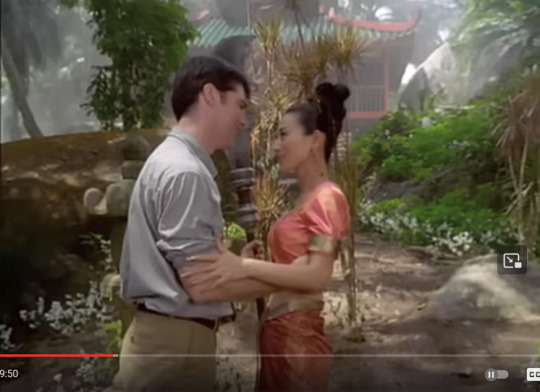
Funny enough I think I see more romantic for humor's sake on Guanyin in comic books or games as likes gags at most. Like in Westward comics (later a tv series) Guanyin has a celestial-turned-demon trying to pursue him that he always rejects. Another is more play for laughs but Guanyin in the Fei Ren Zai where people just don't know it's Guanyin and think she is so attractive.

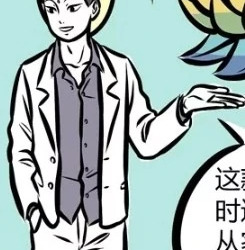
I've seen some games that have Guanyin as like a pretty boy/girl but otherwise nothing even close to a romance plot. Those are more just for like aesthetics of making every character look overly attractive to sell it.
The best I can say is that is just kinda strange and a little strange personally but I can't say that it can be taken seriously. I mean Wukong is supposed to be a Buddha by the end of the novel, so if The Monkey King's Daughter has it that a buddha can have a daughter then there wouldn't be anything stopping the author from having a bodhisattva having kids.
#anon ask#anonymous#anon#ask#sun wukong#monkey king#guanyin#chinese mythos#monkey king's daughter#Wukong is pretty self contained within Xiyouji himself so asking for a little bit of suspension of disbelief can be understood#but Gaunyin has a much longer history that is far more embedded with Buddhist mythology#She isn’t just a character in Xiyouji#and it would be limiting to her just to make it so#but I do think that might be the case in some media when it comes to portraying Gaunyin#esp since most modern interpretations of Guanyin are from xiyouji material just cause the sheer amount of xiyouji content there is#I rarely see Guanyin stand alone moves/shows and there are some trust me but most of her portrayals are within xiyouji spaces#there is a lot of conversation about xiyouji either being a reconstruction or a deconstruction of religion#and while the book is SATURATED in allegorical meaning whether in taoism buddhism or chinese lore it is also seen as satire of religion#people can take xiyouji as pointing out the flaws in humanity but also the flaws of heaven as well as it humanizes both gods and buddhas#this kinda of humanization can be seen as disrespectful to a certain extent but it is what makes these figures more engaging as characters#from a writing standpoint at least#this is me just rambling now about the interesting dycotomy that xiyouji has and has had with religion and how that can be see as today#to a certain extent a lot of directors take xiyouji plots as also their own way to show the heavens in their own way to convey satire#or humor as well depending on what their direction is aiming for#Some even go so far to make that heaven is just straight up the bad guy and that includes buddha as well which is a FAR more wild take than#just having romance in the heavens#But xiyouji does have it that we see these mythological figures have flaws#that heaven can lie or trick or they can take bribes and its up to the audience to interpretation as either satire or if it is critiquing#perhaps religion itself or rather the religious institutions since we do see both daoist and buddist monks as antagonists in the book#this as nothing to do with the ask at this point but i just wanna say my thoughts
13 notes
·
View notes
Text
Journey to the West info dump!
Journey to the West is four [depending on the version] novels that depict the Journey of a Buddist Monk and his four superpowers deciples. They are going West to get the Tripitaka, a scroll that will redeem any sinner.
The main character of the book is the Buddist Monk, Tang Sanzang:

The most recognizable character, is the Great Sage Equal to Heaven, The Monkey King, Sun Wukong:

Funny how the first 7 chapters are about Sun Wukongs origin story, very entertaining, while Tang Sanzangs origin story was pretty boring to read for me- which is crazy that it was boring because Tang Sanzangs mother bit off his left pinkie toe then send him down a river ! In a basket or something like that-
Crazy stuff
Very good book, I do recommend-
Makes watching things based off of it even more fun, like Lego Monkie Kid

[Finished product]
#jttw#jttw sun wukong#sun wukong#tang sanzang#tripitaka#lego monkie kid#lmk mk#monkey king#info dump#artwork
33 notes
·
View notes
Text
Chapter 58
@journeythroughjourneytothewest
Aww he still worried about his grandkids

Kinda interesting that they add Six Ears has 'false Buddist' claims, 'shortens the ground', and has 'staff of iron'

But that he is also long-cultivated
It sounds like Six Ears could have cultivated without eating humans But he is a spiritual monkey from birth, they seem to be special cases And yeah he has an iron rod as well, but it doesn't say what it came from

I do find it funny they are laughing on the way down Like a couple of scamps

Lots of regrets on here today Sanzang with Wukong and POOR WUJING KILLEd A MONKEY

What matters is that he is trying

Tripi still got faith the monkey is kicking ass

Make that 71, and that so didn't work

Ten Kings of Hell

I know if this means that 130 names were crossed out compared to the 47,000 monkeys he had living with him, or that 130 species of monkeys were ALL crossed off his list, and that even monkeys that have never met Wukong are just immoral now

SO many immortals

Goodness these lists just keep going and going

These poor monkeys damn


15 notes
·
View notes
Photo









More HTF characters as FNaF animatronics
#truffles#buddist monkey#panda mom and cub#sneaky#mouse kaboom#wonder wanda#webster#man-o-war#tick talk#happy tree friends#HTF#ka-pow#fnaf#five nights at freddy's
61 notes
·
View notes
Note
Ok what clever trickery did mk use to steal he staff you my friend have peaked my interest 🤔
So, the thing to know is that in my AU, Qi Xiaotian is the youngest of the four immortal monkeys. Which means that, even without the staff, he still can summon a cloud, summon clones... and shapeshift. And when the pilgrims ran into him and he saw the power of the staff, he decided he had to have it.
Both Red and Xiaojiao supported his desire. And the two adopted siblings put their heads together.
One day, Xiaojiao sent a few demons who owed her a favor to attack a village. This created enough of an issue that Tang Sanzang was sent to do some Buddist prayers and Wukong went with him to make sure he didn't get kidnapped. While they were busy, Xiaotian transformed himself into the form of a young boy.
When the battle was over, the village threw a massive party in celebration. The battle was difficult enough that Wukong was a bit high on victory, enough to accept a glass of wine or two. (Something he hasn't indulged in since Havoc in Heaven.) When the party had died down enough, Xiaotian made his move.
The "young boy" offered to play a few games of Go, playing up the act of being a human child who was just fascinated with these real gods. Wukong, tipsy enough that he didn't use his eyes of truth, agreed. The two played for a while, Wukong winning some and the boy winning some and Tripitaka just having fun cheering them on.
Eventually, they were at a tie. Wukong, having immense fun and still on the victory/wine high, decided to make things a little interesting. If the boy won, he would give him whatever he wanted. He even made a binding oath to it.
The boy agreed.
And then proceeded to completely wreck Wukong.
When the game was over, Wukong kept to his promise. When he asked for what the boy wanted, he was cheerfully told his staff.
Wukong figured that... was impossible. But he could let the kid try and when he couldn't pick it up, he would offer something else. So he set the staff on the ground and told the boy to pick it up.
...which he did.
And, in an instant, Qi Xiaotian transformed into his true form and, with a cheerful thank you, ran off. Leaving a horrified Wukong and Tripitaka in his dust.
And now, because of the binding oath, Wukong can't get his staff back unless Xiaotian gives it back.
Wukong is very upset by this.
#The Iron Princess AU#Lego Monkie Kid#Monkie Kid#LMK#au#Stars Answers#Qi Xiaotian#Sun Wukong#Tang Sazang#Tripitaka
104 notes
·
View notes
Note
I leaned that Buddist Monkey’s ears are diff colors
The more you know
WHAT
4 notes
·
View notes
Note
Tell me more about this conspiracy theory about dragonball as a retelling of journey to the west please
okay, some of this is pretty surface level to the point its just face value but also just more ignored then denied firstly, i must establish ‘journey to the west’ to those not familliar with it- its a 2000+ page long chinese novel from the ming dynasty, like 1600 if i recall, but odd because it focuses on a buddist mindset in a time when china still considered buddism to be a foreign influence. the author uses fairly large sections to critisize the other contemporary options to buddism such as daoism (for being largely unconcerned with helping people or betterment) and confucianism (for being rigid to the point it cant adapt and promote extremely bloated beaurocracies incapable of doing much) as well as to extoll the upsides of budism (namely magic powers) and how badass demons are journey to the west is notable for being the origin of about 80% of all anime tropes and over a dozen anime and videogames are directly based on it son goku, unsurprisingly, is pretty much a dirrect anlouge for son wukong, the magical stone monkey king that was born with laser eyes spends the first 7 chapters becoming about (i lost count) 8+ kinds of immortal, learning how to shapeshift and fly from an old hermit monk, and pissing off most gods of any note and the entire bureaucracies of both heaven AND hell. as i said, this is face value to the point its pretty open

son wukong’s identifying features including a size-changing 8 ton iron staff, being pretty much indestructible even to major gods, being extremely impulsive and moderately arrogant, flight, and pretty much openly admits he has probably eaten some people. this should sound familiar however he is not the main character, Buddha himself buries him under a mountain (which has a magic seal on top because a regular mountain wouldnt be heavy enough to hold him) to try and teach him some humility (which fails) saying he needs to wait untill someone frees him in which case he will be endebted to and be the servant of said free-er. while we progress to the ACTUAL protagonist of the story a bald monk named Tang Sanzang is in fact the central charachter, although his name has been interpereted several ways including Tripiṭaka (also the name of the baskets of scrolls hes supposed to carry). the big B entasks he of the shiny head with the task of journeying from china to india to pick up said sacred scriptures so holy they can redeem anyone and then bring them back to filthy filthy china thats badly in need of these ‘morals’ things people keep talking about. but this is where you start to get a lot of ‘wait, that sounds familiar’ when i describe things like ‘bald monk’ and the adventures cueball the magical is going to go on with his companions of anime
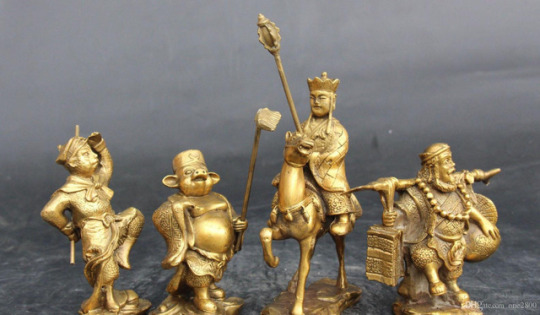
because almost immediately after freeing son wukong from the magic mountain of sityerassdown and putting a magic circlet on his head that causes him great pain when baldy says a prayer to keep him in line (yes this is where inuyasha gets the ‘sit’ necklace) they come across a SHAPESHIFTING PIG DEMON who turns out inst all that bad a guy its just that his new wife is very upset because she thought she was marrying a handsome bishounen despite admitting hes a dilligent worker and treats her well because hes seeking attonement for having eaten people after being kicked out of heaven (where he used to actually be a bishounen in the celestial army) for hitting on women. yet another case of DOES THIS SOUND FAMILIAR
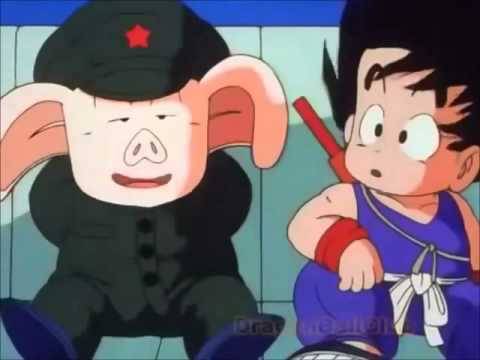
and i just now realize why he was wearing the chinese military officers uniform or at least would sound familiar to people who watched the original ‘dragonball’ and not just DBZ where oolong and the 50 other characters who were all established to be quite powerful when used cleverly were all relegated soely to be sideline cheer squad and ‘hey, remember these guys, from back when this wasnt the kiss goku’s butt show’- which is the point here following the original journey to the west story you started with the magical monkey shenanigans (check) then he learns from hermit (check) how to fly (check) and shapeshift (i guess they thought he was powerful enough without it despite it being one of his major go-to solutions in the story but i get that they already established thats a power someone else had so i understand leaving it out narratively) battling demons, gods, and pissing off the kings of hell and the emperor of heaven (check) and then gets humiliated by Buddha (absent, again i understand leaving this out for narrative tone and to avoid being overly religious in a kids cartoon despite actively leaving king Yema in the story) teams up with the bald monk who they initially clash but becomes his friend over time (check) who then becomes the main protagonist (major not-check) magical monkey jerk is repeatedly scolded for wantonly killing people and given a magical crown of headaches ( fail) teams up with shapeshifting pig who also becomes close ally with useful powers but has deep character flaws (check) and then team up with a dragon who ate their horse who then apologizes by transforming into a horse and then everyone forgets its a dragon (wait, what) and then team up with a river god named sandy (by this time the dragonball plot has already passed mars and is orbiting Jupiter because i think this is when frankenstein appeared and then king piccolo with his sons drum, tamborine, piano, and cymbal, i think goku kills one eats another and asked a samurai if he could eat the third but this is before they retcon piccolo to be a namek {eg- from the planet ‘slug’} instead of a demon because they keep waffling if demons are real) and is then followed by a long list of falling into traps laid by demons because the monk is naive, the pig is cowardly, the monkey is foolhardy, the dragon is too busy staying in his ponysona, and the river deity is carrying the bags narratively this is confusing for several reasons but i could literally teach a college level class on what DBZ does that no writer should ever, EVER, do and every friday to prevent unkind amounts of homework point at how original dragonball at least had narrative cohesion of purpose when it went off in left field but that's part of the journey- in original dragonball everything is a journey of the human spirit for self improvement, in original journey to the west everything is a journey of the human spirit for a shot at redemption, but in DBZ everything is goku is awesome and nobody else is worth his time unless they go ‘ha-ha, i am the most powerful fight punch guy in universe, we must fight’ because fuck anyone who isnt the most powerful being in the universe and even fuck them because they almost never have a reason for being the most powerful and its irritating how shit they are like some of them are mentally five years old who gave you the power to be this dangerous. whats odd is they specifically set it up several times that goku is supposed to narratively step aside and his son(s) step up to carry on the legacy in a return to the earlier more sensable formula, even presenting them as being less powerful as him as an attempt to move away form the absurd escalation issues the series had where goku can destroy a planet by farting yet every thursday they mysteriously find someone five times stronger then the last strongest person in the universe as that wasnt the point in either original dragonball or journey to the west where being clever was always far more important then being powerful, especially as son wukong was mostly more powerful then goku anyways but still got in monster of the week shenannegans not solvable by impulsive brutality. they knew this was a problem, they understood that the endless escalation had gone to the realm where the audience had lost any investment and nobody other then goku could be useful to the story to the point that they even had a WHOLE SERIES where to try and counteract the power creep they had some weird explanation goku is actually time traveled or cursed or some shit so hes only a kid and roughly as strong as he was in later episodes of the original dragonball..... close, so close to actually addressing the problem but also keeping so many other problems krillin moving into being the protagonist would have alleviated the majority of the problems DBZ had- the power escalation bullshittery and the complete lack of stakes as you know goku is going to punch the thing untill it explodes after six episodes of yelling and anything without ‘planet gonna go boom’ no longer seems like a problem worth caring about. goku being downgraded to being the impulsive muscle on a team that included others that were less overtly powerful but still narratively useful to the adventure would have also alleviated almost all the ‘everybody who isnt goku is a fragile useless porcelain figurine of a child’ problems that are very counter-intuitive and kind of insulting: in original dragonball, for example, master roshi was the only known human capable of doing the kamehameha which took 50 years to learn (goku learns it by watching it once and that should have been the cap for him being overpowered{a rival teacher had a more powerful version that nobody else learns}), climbed the sacred tower which took 7 years (it took goku about a week, which is well within the realm of where escalation should be), and blew up the fucking moon but in dbz his ‘power level’ is lower then his pet turtle..... despite all of that and being the one who trained goku and krillin allowing them to be absurdly strong in the first place so they apparently forgot their own history. so taking the actual good story points they aready had and throwing them in the trash is a running problem

they even had the setup for krillin being in peril continually, all the ‘krillin dies’ memes are about on par with how often every demon on the road (which they pass like gas stations) are kidnapping and trying to eat Tripitaka, whcih is framed as despite Tripitaka being powerful he isnt as powerful as his allies but never framed as useless, especially as even goku has to seek help frequently, often from non-martial sources instead of the ‘kung fu solves everything’ mindset im unsure if anyone will want to start a fight about my statements regarding daballz but im okay with an intelectual argument about its writing .... how do i tag this? i forgot replies dont let me do that but i need to learn how to tag my rants one of theese days in hopes they actually get feedback
12 notes
·
View notes
Photo
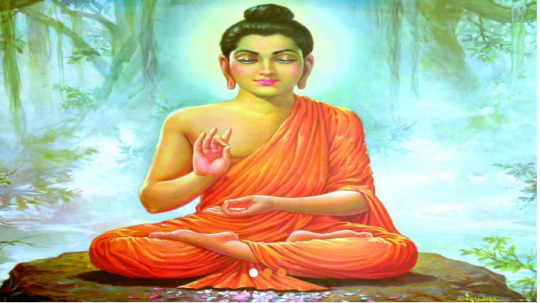
Buddha Temples in India
Born to a royal couple from Kapilavastu, Siddhartha who is popularly known as Gautama Buddha grew up in an environment that hid the fundamental realities of life. His father never wanted his son to be touched by human sufferings and raised him luxuriously. But Siddhartha was destined to detach himself from materialistic life. He chose to lead a life that would inspire the world. In this photo-feature, we will take a look at the four main places that are associated with the life of Gautama Buddha. Thousands of devotees from across the world visit these Buddhism pilgrimage sites. There are five places that are considered to be the main place for the followers of Lord Buddha worldwide.
Mahabodhi Temple Complex-Bodhgaya, Gaya, Bihar, India
Bodh Gaya is the location where, under the sacred pipal tree, Gautama Buddha attained enlightenment and became the Buddha. Gautama Buddha meditated, preached and attained enlightenment under this tree. A simple shrine was built by the emperor Ashoka to mark the spot, and this was later enclosed by a stone railing. To know more click below link
Mahabodhi Temple Complex
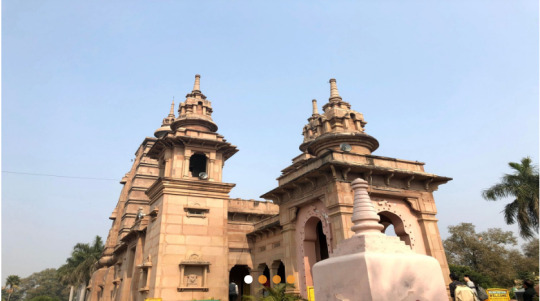
Sarnath Buddhist Temple-Sarnath, Varanasi, Uttar Pradesh, India
Lord Buddha gave his first sermon here after attaining enlightenment at Bodh Gaya. During his reign, Emperor Ashoka came to Sarnath to spread the message of love and peace of Lord Buddha and built a stupa here in 249 BCE. To know more click below link
Sarnath Buddhist Temple
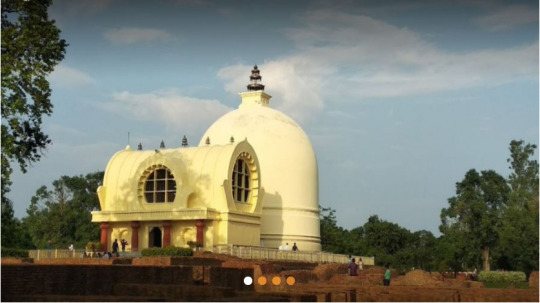
Mahaparinirvana Stupa-Kushinagar, Uttar Pradesh, India
Kushinagar is this place that the Buddha had chosen to free himself from the cycles of death and life and, therefore, it occupies a very special space in the heart of every Buddhist. This houses a 6.10 meter long statue of the Buddha in a reclining position represents the dying Buddha reclining on his right side. To know more click below link
Mahaparinirvana Stupa
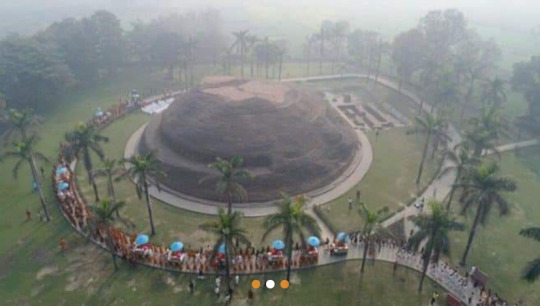
Mukutbandhan Chaitya(Ramabhar Stupa)-Kushinagar, Uttar Pradesh, India
This is where Buddha’s body is said to have been cremated. Architecturally, this half-ruined 15m-high stupa is little more than a large, dome-shaped clump of red bricks. The excavations led by General Cunningham have revealed structures and artifacts related to all sects of Buddhism. To know more click below link
Mukutbandhan Chaitya – Ramabhar Stupa

Jetavana Sahet Mahavihara Monastery-Jetavana, Shravasti, Uttar Pradesh, India
Lord Buddha performed the greatest of his miracles to confound the Tirthika heretics. These miracles include Buddha creating multiple images of himself, which has been a favorite theme of Buddhist art. Shravasti is a huge complex full of Buddhist stupas, viharas, and temples. To know more click below link
Jetavana Sahet Mahavihara Monastery
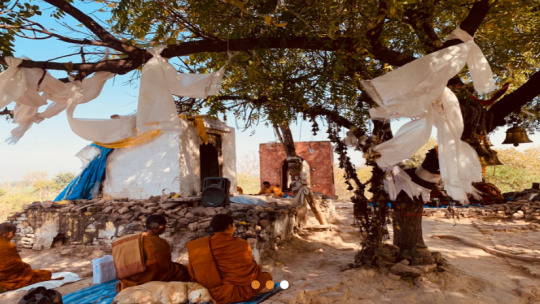
Sankassa Buddhist Site-Sankassa, Farrukhabad, Uttar Pradesh, India
Buddha went up to the Tusita Heaven, spent three months there teaching the Abhidhamma to his mother and then descended back to earth at the village of Sankassya. King Asoka erected one of his pillars here. To know more click below link
Sankassa Buddhist Site
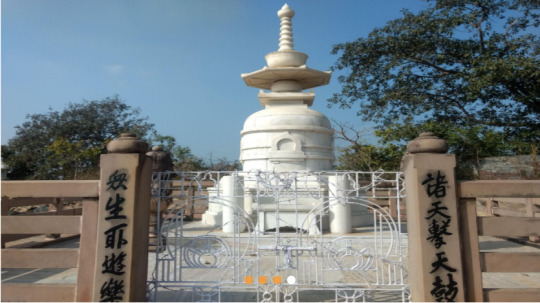
Vishwa Shanti Stupa-Rajgir, Nalanda, Bihar, India
Buddha often visited this place, seeking the solitude and tranquillity of the Jivkamaravana monastery and preaching and meditating at the Griddhakuta hill. At this hill, he converted one of the celebrated followers, the Mauryan King Bimbisara, to Buddhism. When Buddha arrived at ‘Parinirvana’ his devotees held the first Buddhist council at the Saptaparni cave. It was here, that his teachings were penned down for the very first time. To know more click below link
Vishwa Shanti Stupa
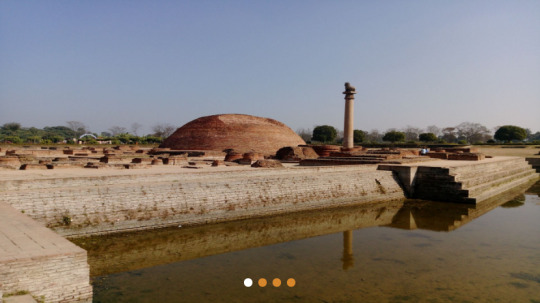
Vaishali Buddist Sanctuary-Kolhua, Vaishali, Bihar, India
Buddha announced the approaching of his Mahaparinirvana here. During one of his visits there, Buddha was offered a bowl of honey by a monkey; this incident is mentioned as one of the eight great events in his life. It was at Vaishali that several people embraced after Buddha had displayed divine presentations of his spirituality. Vaishali is also very important for the fact that it was here that women were made part of Sangha for the first time in the history of Buddhism. Mahaprajapati Gautami, who was Gautam Buddha’s foster mother, had also joined the order at Vaishali with 500 Shakya-women. To know more click below link
Vaishali Buddhist Sanctuary
0 notes
Text
Structure
Freytag’s Pyramid is the Western style of storytelling. Built off the development and leadup to a central conflict, which is negated on the protagonist, before finding a last-bid solution, and ending with a calm final scene.
It again ties back into the Catholic concept of struggling against a great foe or evil, and finding yourself better off for it.

Example of Freytag’s Pyramid in Jack and The Beanstalk:
Exposition - Jack and his Mother live in poverty with their cow, Daisy, who no longer gives milk.
Inciting Incident - Jack is sent to town by his Mother to sell Daisy for as much as they can get.
Rising Action - Jack sells his cow for beans which he is told are Magic Beans.
Complication - Jack’s Mother is furious and thinks the beans are falsehood, tossing them into the garden.
Climax - The beans grow into a beanstalk up into the clouds by the next morning. Jack climbs the beanstalk to find the Giant’s Castle in the sky. He is taken in by the Giant and lives in luxury.
Reversal of Fortune - Jack finds the Giant wants to eat him and must escape.
Falling Action - He therefore steals the Golden Goose and the Harp and makes his way down the beanstalk.
Resolution - Jack cuts down the beanstalk as the Giant chases him, sending the Giant plummeting to his death.
Denouement - Jack and his Mother live in luxury with the Harp and the Golden Goose that lays golden eggs.
Kishotenketsu is the Eastern structure of story writing. Conflict is built in as an unexpected twist with a focus on the inital development of world and characters.
This structure style ties back into Buddist belief of self-improvement with the focus on development, and the twist simply being a distraction from that conquest.

Example of Kishotenketsu in Momotaro:
Introduction - An old woman finds a large Peach floating in the river as she goes to wash clothes. She takes the peach back to her husband who cuts it open to find a baby boy inside.
Development - The boy is named Momotaro, he grows into a bigger and stronger young man after living with his adoptive parents, helping them with chores and housework in the meantime.
Twist - Evil Oni devils harass the local villagers and Momotaro decides to stop them. He trades 3 special dumplings which give you the power of 100 men to a Dog, a Monkey and a Bird.
Conclusion - Momotaro and the party fight off the Oni King on Devil Island together. The King agrees to never harass the villagers again.
1 note
·
View note
Note
There are ancient “sequels” that straight up ignore wukong’s buddhahood and giving him oc kids? Did this author favor taoism too?
I am not too sure about that but I like to think that these are more like the first examples of media that are inspired by Wu Cheng’en's Sun Wukong. Just because there are media out there that has Wukong have children don't mean they are trying to deny Wukong's Buddhist ties or connection that he is the Victorious Flying Buddha, but rather... overlook the idea for the sake of their own narrative purposes. The Supplement can actually fit in “canon” as (spoilers) it is all a dream and Wukongs kids are just a figment of his and the demon's imagination that he accidentally knocked Iron Fan up when he jumped in her stomach. Also, the further that it was a dream was that Red Boy didn’t exist in the dream and Iron Fan only was with Wukong. The author usually explains the tomfoolery by saying “It’s a dream don’t think about it too hard.” Also in Journey to the West After, Sun Luzhen is a stone monkey as well and thus Wukong never went against his vows, simply adopting the stone monkey as his new disciple.
As for Journey to the South, it is more a story about the deity Huaguang dadi as Wukong only makes a guest cameo in the first chapter and the last chapter, the children only being mentioned in the last and even then only Yuebei Xing was the only one with lines and actions. Poor Jidu and Luohou don't even get anything outside of a name-drop. But otherwise, there is also no mention of a wife either. It is left in that territory of... ambiguity where they never really address Wukong having a wife let alone how Wukong got these kids, just that they were his. There is a chance they are adopted but considering he does separate them from his other subjects as he calls his monkey subjects grandchildren, there is a higher chance they are his bio kids. Wukong is addressed by his Great Sage title more often than not but they all acknowledge that he went on the journey is a Buddist disciple under Tang Sanzang as well. So while I do admit it is contradictory I also believe it is one of those cases of "What if"s that is more asking the audience to please give that detail a "suspension of disbelief" treatment rather than trying to make a statement.
I'm not saying that while it would make more sense to keep Wukong as his Buddha title as that is canon in the story, there are a lot of modern media where Wukong does have offspring of some kind for the sake of "what if" cases. Sometimes authors or directors take a lot of leeway with source material for the sake of their own creative ideas and while in most cases I do think that is more for the sake of their narrative purpose than just any religious animosity. I understand that it can be upsetting but Journey to the South does more side-step the idea of Wukong being in a relationship, rather more forced on the idea that Wukong is a father-figure which personally is more of a cute idea that trying to force a romance that is never explored either.
#anon ask#anonymous#anon#jttw#journey to the west#xiyouji#sun wukong#jtts#journey to the south#supplement to journey to the west#journey to the west post#journey to the west after#sun luzhen#yuebei xing#jidu#luohou#Ketu#Rahu#ask
28 notes
·
View notes
Text
Day #3 - Kathmandu is somehow a fascinating place
Nach einer einigermassen erholsamen Nacht in unserem fensterlosen Hotelzimmer, haben wir heute Teile von Kathmandu erkundet. Per Taxi ging es zum Monkey Temple und danach in den Garden of Dreams. Beide Ziele sind willkommene Oasen in einer staubigen und verkehrshektischen Stadt. Die buddistischen Bauwerke, Symbole und auch die musikalischen Mantras sind sehr beeindruckend, jedoch schwer zu verstehen. Ich bin fasziniert! Dank des Lichtfestestes hier hat sich der Verkehr auch etwas beruhigt. Susi trägt trotzdem eine Atemmaske, wie viele andere hier auch. Die Abendszene in Kathmandu sucht ihresgleichen. Es gibt viele tolle Restaurants mit guter Livemusik und tollem Essen. Wir waren im O2RK auf Empfehlung von Sophie. Hat sich gelohnt.
After a good nights sleep in our hotel room without a window, we explored parts of this exotic and crazy city. We took a taxi to the Monkey Temple and went to the Garden of Dreams afterwards. Both destinations are welcome oases in a dusty and traffic jammed city. I am fascinated by all those Buddist temples, shrines, prayer belts, prayer flags and the musical mantra. I cannot comprehend most of what I have seen, but I am optimistic that the coming weeks will enlighten me somewhat. Thanks to the festival of lights the city has calmed down somewhat, but air pollution is still bad enough for many people to wear face masks - including Susi. Kathmandu is hard to beat at night. So many fascinating restaurants to choose from. We went to the O2RK based on a recommendation from Sophie. No regrets!
1 note
·
View note
Note
Buddist monkey.

Always bald~
44 notes
·
View notes
Photo

A sweet story... In my local Tesco Lotus, I was surprised to see two monks in the pet food isle. I was buying cat food for my little monkey cat. They were at the dog treat section. They appeared to be buying some treats for the temple dogs. The elder monk turns to the younger monk and asks in Thai, "Which one do you think is more delicious?" I found this quite lovely.....carefully discussing which one might be the most delicious, for the temple dogs. ❤ #buddism #buddist #thailand #tescolotus #tesco #dogfood #temple #templedogs #dogs #goodheart (at Thailand)
1 note
·
View note
Text
Japan- Complete Guide to Hakone visit from Tokyo – Hakone Free Day Pass
Japan- Complete Guide to Buying and Using a Japan Rail Pass
Handy guide to Japan Culture and Etiquette
As I stood in Kyoto station outside the JR ticket counter waiting for Amrita and Ohanna, all I could focus was at the bakery right across. I dragged a rucksack, suitcase and a small bag to grab the best chocolate croissant we ever had. It was mountain day, and the station was busy with people travelling all across the country. Worlds 2nd fittest country has a holiday calendar with days dedicated to Mountains, Sea, Star, and a Dolls & Girls Festival. It gives you an idea of how well nature and people are synchronised with each other. Japanese are calm and crazy at the same time, with shrines and Zen gardens all around to love hotels and insane fashion trends, it’s all pretty mind-boggling.
It just seems impossible, travelling to a country where they don’t speak your language and your 6-year-old who has a mind of her own and doesn’t care what you say, in my wildest dreams I had not imagined that it would be so easy travelling in Japan. If you leave your passport or purse somewhere and it comes and finds you, nobody is begging, it’s clean, nobody can be more punctual and mind it; it is considered rude if you count the change you get back while shopping. It’s a different world… a place that’s worth exploring. From Monuments and Shrines to Mountains and beaches, Japan has everything to offer, and visiting them is easier than you think. With an incredible network of worlds best trains, buses, trams and flights you’ll be spoilt for choice.
Delhi – Narita Airport –Tokyo – Kyoto
Kyoto, the earlier capital of Japan, intrigued us as much as Tokyo. With a history of more than 5000 years, love for Zen gardens and a mention in Steve Jobs biography, we decide to visit Kyoto first.
So we exchanged our voucher for JR Pass and took the NXT train to Tokyo central to catch the next Shinkansen for Kyoto. With only two subway lines, the best way to travel in Kyoto is by bus. We took a bus from the Bus terminal right outside Kyoto Station to MyStays Hotel located in Downtown Kyoto.
Kyoto District Map
Downtown Kyoto is close to most of the attractions in town and travelling with my daughter I wanted to be located centrally. Next four days we went all out exploring Kyoto’s innumerable shrines and its cuisine at our slow pace. Wherever you might be in Kyoto, Google maps will always show a Shrine close by. Kyoto has options for hikes and cycling routes, and most of the attractions are starting points for these hikes. We checked official Kyoto Tourism page for latest events and found the Light and sound show on Thousand Demons at Kodaiji Temple.
Exploring Kyoto with a Bus Pass
Buy a one or two day pass depending on the length of your stay and days itinerary for unlimited bus rides during that period. This will take you to almost all corners of Kyoto. It’s always on time, and the best way to find your bus is to use google maps. They also give a city map to get a better idea of the different route the buses ply on.
Top Things to do in Kyoto
Temples- Shrines – Bamboo Forest- Food – Culture – History- Hikes and Cycling
Ginkakuji Temple
Arashiyama – Bamboo Forest & Monkey Garden
Chion-in Temple & Kyoto Station
Kyoto Station building is a sprawling commercial building with train stations, shopping and great restaurants. Kyoto Bus Stand is right outside. Take a bus or do a 10 min walk to the Chion -in Temple.
Gion & Maruyama Park
Yasaka Shrine
Gion is lined up with fantastic shopping, lanes filled up with fabulous restaurants and eateries alongside Mikasa river. A shrine is never far away, and Maruyama Park connected to Gion has a collection of magnificent shrines and temples. This is a must visit during your Kyoto trip
Kodai-Ji Temple
We visited this temple during the festival of 1000 demons with a light and sound show
Fushimi Inari-Taisha – The mountain of faith will test yours so go prepared
Kinkaku-Ji/ Rokuon-Ji- Now a Buddist Aen temple was earlier retirement vill of the shogun
Ryonji
Nishiki market – Street Food, Restaurants & Shopping
Amazing Day Trips from Kyoto using your JR Pass
Kanazawa
Nagahama
Himeji
Enryukuji
Hiroshima
Osaka
Kobe
Hikone
Destination Tokyo
Tokyo is one of those rare cities of the world which has world-class infrastructure on one hand and temples and shrines on the other dating to more than 5000 years. The normal and extreme walk hand in hand. Buildings dedicated to Karaoke Bars, Gaming arcades, Love Hotels, fine dining to the best tea drinking ceremony, samurais and sumo wrestlers. Could I intrigue you more?
Travelling with our daughter, we wanted to choose a place which was close to the attractions we had planned to take her on this trip. We took up an Airbnb in Nippori area. This was a blessing in disguise as we were in a lovely and quiet residential area with all necessities within walking distance like the Belgian cafe across the road.
Top Things To Do In and around Tokyo with Kids
Disney land and Tokyo Sea World– Book the Disney resorts or hotels for comfortable transfers and other benefits. If you are staying out like us, reach the resort at the opening time of 8 am by subway to Maihama station. Also, plan and book according to the footfall on those particular days. Check it here: Disney Crowd Calendar
Ueno Park. Visit this park for:
Ueno Zoo| National Museum of Nature and Science| Shinobazu Pond |Tokyo National Museum| National Museum Of Western Art| The Ueno Royal Museum
Hakone Day Trip
Even on a short trip to Japan, it is imperative to move away from Tokyo to understand the flow of energy, beauty and calm which is part of Japanese life all across the country. The best way to do this is to take a one or two-day trip to Hakone which is less than 100 km from Tokyo. Part of Fuji- Hakone- Izu National Park, It’s a hilly area with fantastic views of Mt Fuji from various locations like Lake Ashi, Ropeway stops, Hotels and more. Read: Japan- Complete Guide to Hakone visit from Tokyo – Hakone Free Day Pass
Kamakura Beach
If the weather is good head out to the beaches around Tokyo. Train rides with slightly more than an hour will get you there.
Hato Bus Tour is perfect to know the cities routes and various famous shrines. We loved the tour and especially our visit to Meiji Shrine located in a 170-acre jungle in the heart of the city. Click here to Book a Hato Bus Tour
Museum of Maritime Science
Lego land
Boat Tours
Tsukiji Fish Market
Planning the Japan TRIP
Japan Visa (http://www.vfsglobal.com/japan/india/)
At INR 1150 is super cheap if you are applying from India. They would generally give a multiple-entry visa with a maximum stay depending on your itinerary. Document checklist is available online and the whole process takes almost seven working days. Also, check out JAL Airways for Promotional offers.
Japan Railway Pass (https://www.jrailpass.com/)
For travelling within Japan though you have a lot of flight options, I would highly recommend buying a JR pass. If you buy a single ticket, it can be very expensive but a JR pass will start saving you money from the first trip itself Stations are located centrally and are easy to approach. Frequency is enough for you to make a pretty flexible plan just in case of any last minute changes. They have options for 7, 14 and 21 days. Special discounts for kids and senior citizens. If it is a last minute trip, you can buy it from an authorised travel agent in your city too. Insist on the free Japan travel guide with it.
Note: has to be bought outside Japan before arrival.
For more information on JR pass click: Complete Guide to Buying and using a Japan Rail Pass
Travel Insurance
It is one of the most important things for the trip. I’ve sworn by it since the day I started travelling internationally. Depending on the policy, it covers all your medical bills, lost luggage and other emergencies.
I recommend: ICICI Lombard and Bajaj Allianz
Pocket Wi-Fi Modems
They generally work for 10 devices and are very useful. It can save you loads of time, as you can check Train times, Shinkansen Train schedules, bus routes, locating restaurants and last minute Cab Bookings.
Book them on JR pass site or various other providers in Japan. They can be collected at the Airport from their respective counters as you land into Japan. You can also go directly and pay and pick up a device, but sometimes in peak season, they are out of stock. So do pre-book.
Links: https://www.jrailpass.com/pocket-wifi
https://www.econnectjapan.com/
https://www.pupuru.com/en/
Hotel Bookings
With few amazing apps, the process of booking rooms has become super easy. I always research the things to do in a city and the book as close as possible to them within my budget. Booking in Japan was a little different; there are a few room types to choose from.
Ryokan | Cube Hotels| Vacation Rentals| Standard Hotels (Budget- Mid-range – Luxury)
Booking.com – If you are not sure but want to block the rooms without paying till a cutoff date.
Agoda.com | Expedia.com| Airbnb.com
We stayed at Mystay Hotel, Kyoto and Airbnb, Nippori Area, Tokyo
Tokyo Currency:
Cash is preferred at most places, and sometimes it can be difficult to find ATM machines in some part of the town or as you travel to lesser touristy areas of Japan. We were carrying Dollars, and our first exchange was at Narita Airport and remaining in the city.
1 INR = 1.76 JPY
1 USD = 107 JPY
Average Meal: 600 yen
Food on the Shelves (7 Eleven, Family Mart, Lawson, Daiso): 300 yen
Ramen and Gyoza (Momo/Dim Sum) in most of the restaurants are 300 yen too.
Don’t miss the most amazing bakery products available all across Japan
Apps to make it all Easy :
City Happenings: TimeoutTokyo| City Tourism websites
Finding Food: GoogleMaps|Yelp|Gurunavi|Bento.com| tabelog.com |openrice.com |opensnap.com
Booking Tours and Activities: Japantravel | Viator |Tripadvisor |Visitacity
Transport: JREastTraininfo| Japanrail|Japantaxi|Navitime|Kyotobus |Googlemaps| Japanguide.com
Conversion rate– xCurrency
Lost in translation: GoogleTranslate| Duolingo (learn basic Japanese)
Understanding Culture and Etiquette is essential in Japan. By following them, you are able to scratch the surface and get a better understanding of the place and a sense of belonging. Empty your cup as you enter Japan, It has so much to teach and offer that it changes the way one lives. Read Complete guide to Japanese lingos and Etiquette Handy Guide to Japan Culture and Etiquette
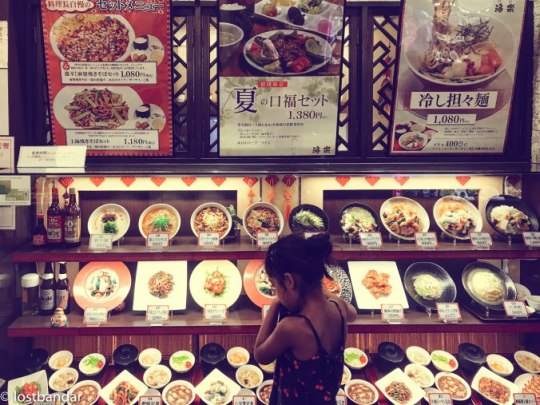
Japan with my 6 year Old Japan- Complete Guide to Hakone visit from Tokyo – Hakone Free Day Pass Japan- Complete Guide to Buying and Using a Japan Rail Pass…
0 notes
Note
How was wu cheng’en able to access so much knowledge for his book?
I mean, the story of Xuanzang's travel was fairly popular and the building blocks of Xiyouji were all right there! An example of a previous interaction of Xiyouji is Zaju being a casting different story but already having some demons and arcs that were already set. Wukong, Bajie, Wujing, Sanzang, and Bailong were already there as characters but it was the Wu Cheng'en version that was what gave them that character change Wukong's character throughout the years.
When it comes to the transformation of the character that is something I would highly suggest looking into Transforming Monkey: Adaptation and Representation of a Chinese Epic by Hongmei Sun for a more in-depth study of like the changing of the legend passed down in a good cohesive manner which is what I think is at least a great way to simplify how these legends were told and retold and changed depending on the periods they were in. The story was insanely popular already and it wasn't terribly hard to either hear the story to even see a performance or oral telling of the tale. But there was a lack of writings over the story in compassion as such those were a bit harder to find.
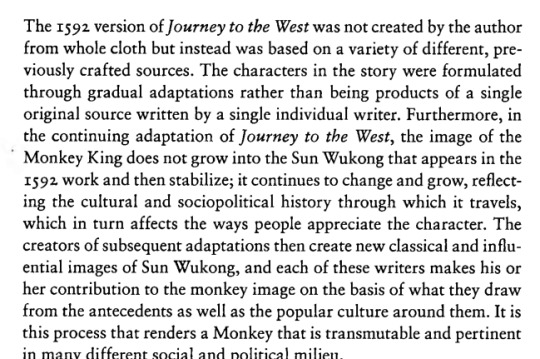
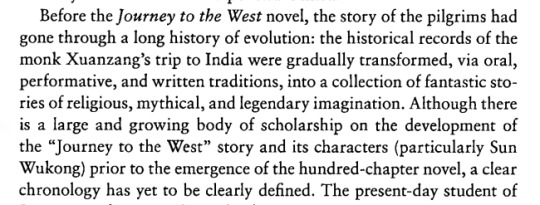

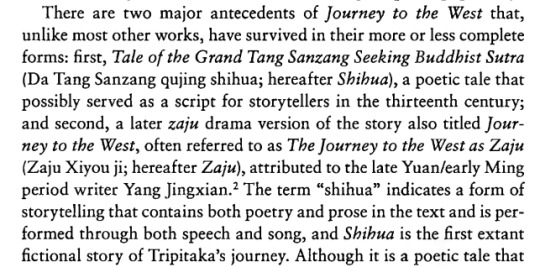
But in short, Wu Cheng'en was a scholar was while he failed the imperial examinations he was still devoted to spending his life as an artisan, including classical literature, popular stories, and anecdotes. He did become an official and had postings in both Beijing and Changxing County, but he resigned and spent the rest of his life writing stories and poems in his hometown.
During this time he became an accomplished writer, producing both poetry and prose and became friends with several prominent contemporary writers. So he has a history of writing already, being active in other works (though none similar to Xiyouji). Dissatisfied with the political climate of the time and with the corruption of the world, he spent much of his life as a hermit. Considering the political commentary and the vast amount of Buddist, Taoist, and Chinese folklore that is within Xiyouji, Wu Cheng'en was considered to be a great candidate by other reports to be someone to have a collection of lore, literature, political information, and the skills to put it all together in his later life as a hermit. In the early 20th century, Hu Shih and his students conducted textual analysis and research into Qing dynasty records and suggested Wu as the author. Translator W. J. F. Jenner points out that although Wu had knowledge of Chinese bureaucracy and politics, the novel itself doesn't include any political details that "a fairly well-read commoner could not have known." It is unknown how much of the novel was created, and how much was simply compiled and edited, since much of the legend behind Journey to the West already existed in folk tales.
#Transforming Monkey: Adaptation and Representation of a Chinese Epic#Hongmei Sun#anonymous#anon#anon ask#jttw#journey to the west#xiyouji#sun wukong#ask
21 notes
·
View notes
Note
There’s apparently a saying that JTTW would not have been written by a religious person and kind of surprised since I thought it was pro-Buddhism
It’s more that it would not have been written by a monk or abbot when they say that as while Xiyouji is very much taking elements of Buddism, it has a lot of other elements beyond Buddism as well. It has Taoist gods living with Buddist deities combining both Chinese folklore and even Indian-inspired legends. It is a fascinating combination of cultures, religions, and philosophies. And so it isn’t too extreme to think that more of a third party would be able to take from this, combining these elements with a bias that Buddism is the end-all goal while still staying respectful to Taoism and Taoist deities. There were some tensions between the two in some locations, something that is seen in Xiyouji as well as there were a lot at least 2 arcs where Buddhist monks were being enslaved or persecuted in some way.
But there are also Buddhist abbots in the books that are greedy, there are arhats that take bribes. There are some people that think that Buddha is actually shown in a bad light being the antagonist in the book when facing Wukong. Despite being the one to protect heaven and being seen as the only one that can truly control Wukong/the Mind Monkey. I’m personally not a fan of that interpretation but rather think they give a lot to Western heaven. Again I can’t speak for everyone on how they feel but I truly think that
Wu Cheng’en does paint that cultivation through Buddist can show self-improvement of the spirit but he also says that about Taoism. He sells more an idea of continual self-improvement never trying to paint that the heavens or the earth are perfect, which is the ending of the book that he was trying to sell as well.

13 notes
·
View notes